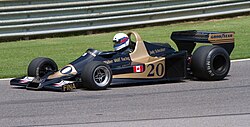 The WR1 demonstrated at Barber Motorsports Park in 2010 | |||||||||||
| Category | Formula One | ||||||||||
|---|---|---|---|---|---|---|---|---|---|---|---|
| Constructor | Walter Wolf Racing | ||||||||||
| Designer | Harvey Postlethwaite | ||||||||||
| Successor | Wolf WR5 | ||||||||||
| Technical specifications [1] | |||||||||||
| Chassis | Aluminium monocoque, with engine as a fully stressed member. | ||||||||||
| Axle track | Front: 1,410 mm (56 in) Rear: 1,524 mm (60.0 in) | ||||||||||
| Wheelbase | 2,616 mm (103.0 in) | ||||||||||
| Engine | Ford Cosworth DFV 2,993 cc (182.6 cu in) 90° V8, naturally aspirated, mid-mounted. | ||||||||||
| Transmission | Hewland FGA 400 6-speed manual gearbox | ||||||||||
| Weight | 585 kilograms (1,290 lb) | ||||||||||
| Fuel | FINA | ||||||||||
| Lubricants | Castrol | ||||||||||
| Tyres | Goodyear | ||||||||||
| Competition history | |||||||||||
| Notable entrants | Walter Wolf Racing | ||||||||||
| Notable drivers | | ||||||||||
| Debut | 1977 Argentine Grand Prix | ||||||||||
| |||||||||||
The Wolf WR1 was a Formula One car built for the 1977 season by the Walter Wolf Racing team. Four examples of the car were produced. The first, completed well before the start of the season, was the WR1. Another two identical cars were built: WR2, finished ahead of the first race; and WR3, ready in March 1977. At the end of the season, a fourth car, WR4, was produced with slight adjustments, and WR1 was remodeled in similar fashion for 1978. [2] The original car was driven exclusively by South African future 1979 World Champion Jody Scheckter in 1977. WR3 and WR4 were also driven by fellow future World Champion Keke Rosberg in the 1978 season.